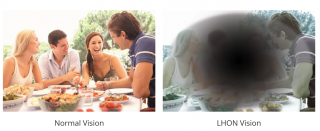Shedding light on LHON: the rare blindness affecting young adults

People in Europe with this little-known and frequently misdiagnosed condition need faster diagnosis.
Blindness is a condition most readily associated with old age and certainly not with young people. However there is one rare, genetically-inherited disease which can rob young adults of their sight in the space of just a few months.
That disorder is called Leber's hereditary optic neuropathy, or LHON.1-4
A progressive disorder that is passed down the maternal line, LHON impacts approximately two out of every 100,000 people in Europe and typically presents between the ages of 27 and 34.
The genetic mutations responsible for LHON affect the mitochondria, which are small structures in the cells that are responsible for generating energy. Mitochondrial DNA mutations lead to an energy deficit in the cells and, most importantly, increased levels of free radicals. In the cells that form the optic nerve, this change results in them not functioning adequately and, ultimately, the cell dies. The optic nerve is particularly vulnerable to such mitochondrial dysfunction.
The disease causes a rapid and severe loss of central vision, initially in one eye, and typically affects the second eye in weeks or a few months. Its progression is fast, resulting in around 80% of LHON patients being legally blind within one year of the onset of symptoms.
LHON severely impacts quality of life, leading to considerable economic and social costs due to productivity loss, lower employment and income loss.
[caption id="attachment_31716" align="aligncenter" width="320"] Normal vision versus the vision of someone with LHON[/caption]
Normal vision versus the vision of someone with LHON[/caption]
Too long a wait for diagnosis
Despite its rapid onset and progression, the average time it takes for LHON to be diagnosed is worryingly long.
Prof Wolf Lagrèze, an ophthalmologist in Germany, often sees patients whose disease has already progressed substantially.
“Unfortunately, many of the patients that are eventually diagnosed tend to be in the trough of their progress,” he explains.
Other European countries are struggling, too. In recent years, the average time for diagnosis through the Spanish healthcare system has lengthened from between one and three months to over a year, says Dr Lorena Castillo, neuro-ophthalmologist in Spain.
“The problem in my country is a lack of efficiency – there simply isn’t enough awareness of the condition among physicians.”
This is exacerbated by limited availability of adequate technology to carry out the genetic testing required. In Spain, there are centres equipped to carry out full mitochondrial DNA testing – the biggest being in Barcelona, Madrid and Zaragoza – but cost is a major obstacle.
A need for greater awareness
A core issue, though, is the lack of awareness about LHON among healthcare professionals.
Long diagnosis timelines are, in large part, due to doctors confusing LHON with other visual conditions that exhibit similar characteristics.
“Only in rare instances are patients given the correct diagnosis early on,” says Prof Lagrèze. “One of the most common mistakes made with LHON is mistaking it for other conditions with matching symptoms, such as optic neuritis.”
A symptom of multiple sclerosis (MS), optic neuritis causes a similar loss of vision in one or, rarely, both eyes. Unlike LHON, though, in most cases, optic neuritis improves on its own and patients regain their sight.
Indeed, in the UK, the possibility of MS was raised for Russell Wheeler’s son. He had seen an ophthalmologist and a general practitioner but, only after both MS and a brain tumour were ruled out, was LHON raised for the first time in their journey to a diagnosis.
“If there was better guidance available to ophthalmology departments about LHON then at least the possibility of LHON could probably have been considered earlier and blood tests arranged sooner,” says Wheeler.
A similar situation was experienced by Fabrizio Sottile, Italian Paralympic champion swimmer. Having lost vision in his left eye in March 2010, he did not receive a definitive diagnosis of LHON until September that year.
“The first diagnosis I was given was of MS, despite informing my ophthalmologist and neurologist of cases of LHON in my family,” explains Sottile. “After four months and more deterioration of vision in my right eye, we decided to see another ophthalmologist, who knew about the disease but didn’t know how to treat it.”
A need for efficiency, co-ordination and information
Tackling the challenge of LHON goes further than just raising awareness, however. Health systems across Europe need to improve how they approach LHON.
In many European countries, positive elements already exist. For example, screening programmes for families with a history of LHON are available in Germany, Spain, the UK and Italy.
But the big problem is getting people to the right place, states Prof Lagrèze. Dr Castillo says that the situation is similar in Spain; the “good intentions” are there, but the resource to provide timely LHON care simply doesn’t exist.
In the UK, centres in Newcastle, Moorfields, Oxford, Manchester and Cardiff have knowledge of the condition, but research into it "remains unco-ordinated, with some main priorities ignored," Wheeler points out. And in Italy, information about LHON treatment is sparse, says Mr Sottile.
The European LHON community needs greater patient advocacy. The following groups active in the region:
- France – Ouvrir les Yeux
- Italy – Mitocon
- Spain – Asociación Atrofia Nervio Òptico de Leber (ASANOL)
- Sweden – LHON Eye Society
- UK – LHON Society
- Germany - PRO RETINA
These valuable support communities are the primary sources of information and advice about LHON in their respective countries, compensating for the little availability through national health systems.
Wheeler says his family’s experience was more about educating the doctors and nurses, rather than the other way round.
“If anything, the information flowed in the opposite direction, as we passed on the fruits of our own research to the professionals involved in our diagnosis,” he explains.
For more insight on LHON access our spotlight on the condition here.
References
- OMIM (2011). Leber Optic Atrophy. Available at: http://omim.org/entry/535000 (accessed September 2017).
- Yu-Wai-Man P, Chinnery PF. Leber Hereditary Optic Neuropathy. 2000 Oct 26 [Updated 2016 Jun 23]. In: Pagon RA, Adam MP, Ardinger HH, et al., editors. GeneReviews® [Internet]. Seattle (WA): University of Washington, Seattle; 1993-2017. Available from: https://www.ncbi.nlm.nih.gov/books/NBK1174/ (accessed September 2017)
- Köberlein J, Beifus K, Schaffert C, Finger RP. The economic burden of visual impairment and blindness: a systematic review. BMJ Open 2013; 3:e003471.
- Kirkman MA, Korsten A, Leonhardt M, Dimitriadis K, De Coo IF, Klopstock T, Griffiths PG, Hudson G, Chinnery PF, Yu-Wai-Man P. Quality of life in patients with leber hereditary optic neuropathy. Invest Ophthalmol Vis Sci 2009; 50:3112-5.
About the author:
Marco Ricci is a former Staff Writer at pharmaphorum. Contact us at: editorial@pharmaphorum.com or on Twitter @pharmaphorum
 This article was funded by Santhera. To find out more about Santhera and its work in LHON, click here.
This article was funded by Santhera. To find out more about Santhera and its work in LHON, click here.
For more LHON information and patient stories click here to view the pharmaphorum Spotlight










